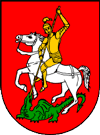The Municipality of Šentjur is among the largest in Slovenia. With a surface area of 222.3 km² (54,931 acres) and a population of around 20,000, it comes in at twenty-third and twentieth place, respectively, in the country. It is located in the south-eastern part of Slovenia and is part of the Savinjsko statistical region. It borders on 11 municipalities, of which only two are more populated and expand over a larger area. It has 13 local communities and 108 settlements. The traffic infrastructure is good in terms of both roads and railway. In Šentjur there is an intersection of the roads from Celje to Rogaška Slatina, Sevnica and Podčetrtek. In Dramlje there is a slip road to the Maribor - Ljubljana motorway. The municipality has five railway stations: in Šentjur, where the Southern Railway Museum displays a rich collection of archives and rail devices from 1844 onwards; in Grobelno where there is a rail intersection; in Ponikva, Ostrožno, and Dolga Gora.
The town of Šentjur is the centre of the municipality and also the administrative, as well as demographic and employment centre.
The hilly municipality stretches from the vineyards of Dramlje and Dolga Gora on the north to the forests of Bohor and Veliki Javornik which is the highest peak (1023 m or 3,356 feet above sea level) on the south. The landscape has two drainage areas, numerous brooks, ponds in Blagovna, a thermal spring in Dobrina that is known to have healing properties and the lake Slivniško jezero in the central part making this a municipality abundant in water. The Karst features that can be seen in Ponikva and Planina pri Sevnici give the area a certain charm. The southern part with its unspoilt nature extends to Kozjansko National Park.
The municipality has been inhabited since prehistoric times, evidenced by the various objects from the Neolithic period that have been found there. The younger settlements were found in the archaeological sites in Gradec pri Praprotnem, Tinje, Loka pri Žusmu and Rifnik. All of them are located south of Šentjur. The latter has been thoroughly explored and is an archaeological park. All of the finds from that area are on display in the museum "Rifnik and its treasures" that is located in Zgornji trg square in Šentjur. Other periods of history are represented by a number of museum collections and cultural monuments. Several prominent citizens from this area played an important role in the development and recognition of the municipality: the first Slovene to be Beatified, Anton Martin Slomšek; the Ipavec dynasty of composers and doctors; the cartographer and geographer Blaž Kocen; the freedom fighter Franjo Malgaj who fought for the northern border and many others including the folk hero, Franc Guzaj who was a real life Robin Hood from the Kozjansko region who took it from the rich and gave it to the poor.
The hilly landscape provides good conditions for the development of modern agricultural production with an emphasis on animal husbandry, horticulture and viticulture. In the past good transport links enabled the growth of industry. Even today, with the help of equally important factors such as spatial possibilities, willpower and an in depth knowledge of the local population, contribute to rapid development and facilitate entrepreneurship in the processing industry, commerce and various other businesses in the trade and industrial zone in Šentjur, as well as elsewhere in the municipality.
Also tourism, mainly farm tourism, has gradually developed in the municipality. The natural environment is relatively well preserved and offers many opportunities for leisure activities (biking, hiking, horseback riding, hunting, fishing ...). It is possible to attend many cultural, sports and tourist events, which take place in the municipality throughout the year. All these factors contribute to the growing number of tourists who gladly return to the area.
The establishment of RAK - Kozjansko Development Agency has been beneficial. The agency provides assistance and information to municipalities, businesses, craftsmen, farmers, associations and other interested parties, in relation to national and European tenders; all of which give an opportunity for the entrepreneurs, agriculture and tourism to develop.
Also industry in the area is developing, with a focus on the metalworking industry. A series of large and small companies have opened, that have won recognition in the demanding European and world markets.


